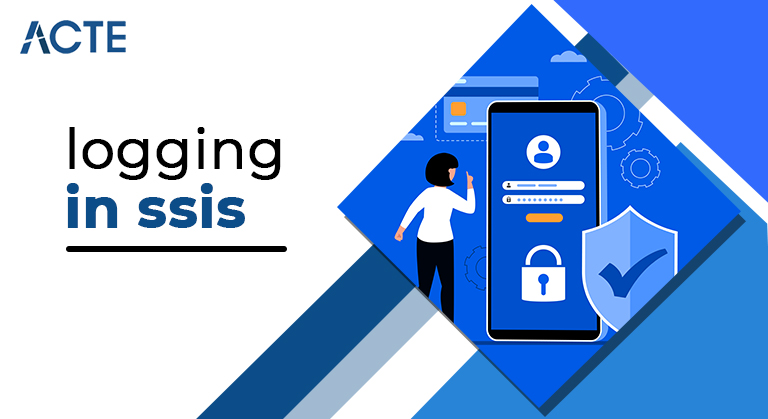
What is Logging in SSIS ( SQL Server Integration Services ) | A Complete Guide with Best Practices
Last updated on 15th Dec 2021, Blog, General
SSIS log provider for Text files: We use this log provider to store information in a TXT or CSV format. Usually, developers use this format to store logs information. SSIS log provider for SQL Server: We can store the SSIS logs in the database tables. It makes it easy to query the logs using the t-SQL queries.
- Introduction to SSIS
- History of SSIS
- SSIS Toolbox
- SSIS Salient Features
- SSIS Architecture
- Different methods of SSIS Package Logging
- Why we use SSIS
- SSIS Tasks Types
- Advantage and Disadvantage of SSIS
- Conclusion
Introduction to SSIS:
Microsoft SQL Server Integration Services is also known as SQL Integration Service or SSIS. SSIS is a business intelligence tool that provides data conversion solutions for various organisations.
SQL Server Integration Services is an ETL tool (Extract, Transform, and Load). It means that SSIS can be used to extract data from various sources such as Excel files, Flat files, XML files, Relationship websites. Additionally, modify (piece and dice) according to your needs and finally upload the data to your destination.
What is the SSIS workspace, and how is this used to create SQL Integration Services projects. We divided the window into different parts
Solution Test: This is a combination of project-level communication managers, actual packages, and project parameters.
Properties: Use this window to customise features for all functions.
Toolbox: The SSIS toolbox provides a wide range of built-in functions, containers, modifications, resources, destinations, and administrative tasks to solve complex business problems. Use these clear SSIS tools by dragging and dropping those functions into the workspace. It means we don’t have to write one line of code to do multiple tasks.
Info: Displays information about toolbox items.
Connection Managers: This window is for creating connection level package managers.
Package: Design an SSIS package
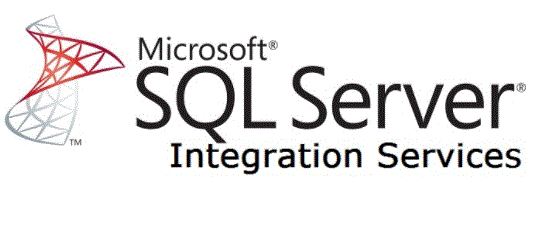
- Previously, on SSIS, SQL Server, information Transformation Services (DTS) were used, which was a part of SQL Server seven and 2000. SQL Server 2005 The Microsoft team set to structure the psychosis. However, rather than change the psychosis, they set to launch product Integration Services (SSIS).
- 2008 SQL Server Version There area unit several performance enhancements created on SSIS. New sources are introduced.
- SQL Server 2012 was a serious unleash for SSIS. With this version, the conception of the project submission model was developed. It permits all comes, and their packages are sent to the server, rather than specific packages.
- SQL Server 2014 during this version, there don’t seem to be several changes created to SSIS. however new sources or changes are created with totally different downloads via CodePlex or SQL Server Feature Pack.
- In SQL Server 2016 This version permits you to use all comes, instead, individual packages. There area unit a lot of resources particularly cloud, and massive information sources and a number of changes to the catalogue.
History of SSIS:
- Move the Toolbox item to another section
- Right-click an item in the SSIS Toolbox, then click one of the following:
- Move to Favourites
- Move to General
- Move to Other Sources
- Move to Other Places
- Submit to Other Changes
- Move to Other Tasks
SSIS Toolbox:
In the SSIS toolbox, the control flow and data flow components are organised into categories. You can expand and fold sections, and rearrange sections. Restore the default organisation by right-clicking inside the toolbox and clicking Restore Defaults on Toolbox.
General preferences and categories appear in the toolbox when selecting control flow, data flow, and event holders. The Other Tasks section appears in the toolbox when you select the Control Flow tab or the Event Holders tab. Some Changes, Other Sources, and Other Access Categories appear in the toolbox when you select the data flow tab.
Add Azure components to the Toolbox
Azure Feature Pack for Integration Services contains communication managers to connect to Azure data sources and operations to perform common Azure tasks. Install Feature Package to add these items to the Toolbox. For more information, see the Azure Feature Pack for Integration Services (SSIS).
- Studio Location
- Compatible data collection activities
- Active start-up speed
- Strong integration with another Microsoft SQL family
- Modification of Data Mining Question
- Unexplained Views and Group Changes
- Term Release and Time View Changes
- Communication components of high-speed data such as SAP or Oracle communications
SSIS Salient Features:
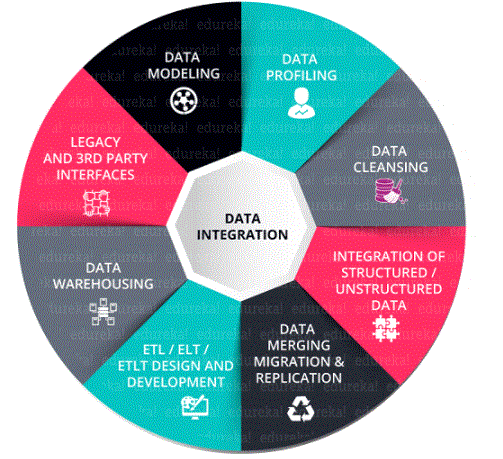
- Flow Control (Container Containers & Activities)
- Data Flow (Source, Location, Transformation)
- Event Host (messaging, emails)
- Package Explorer (Provides one view of all packages)
- Parameters (User Interaction)
- Let’s understand each part in detail:
- Sequential Container
- Loop container
- Foreach Loop Container
- Sequence Container: allows you to organise sub-tasks by combining them, and allows you to use transactions or assign logs to containers.
SSIS Architecture:
1. Flow Control – Flow control is the brain of the SSIS package. It helps you to plan the execution of all its parts. The sections contain containers and functions controlled by the previous issues.
2. Initial Obstacles – The Precedence constraint is part of a package that directs the activities to be performed in the previously described sequence. It also describes the workflow of the entire SSIS package. It governs the performance of two interconnected tasks by performing local tasks based on the result of previous work – business rules defined using specific expressions.
3. Work – ‘Work’ is an individual unit. It is the same method / function used in planning language. However, in SSIS, you do not use encoding. Instead, you will use the drag and drop method to design the area and prepare it.
4. Dishes – A container is a unit of work that combines functions into units of work. In addition to providing visual flexibility, it also allows you to specify the variables and event handles that should be within the scope of that particular container.
The four types of containers on SSIS are:
In loop container: Provides the same functionality as a sequence container except that it also allows you to run tasks multiple times. However, it is based on a test condition, such as a loop from 1 to 100.
For each Loop Container: Also allows for loop. But the difference is that instead of using the status quo, the loop is made over a set of objects, preferring files to a folder.
5. Data Flow – The main use of the SSIS tool is to extract data from server memory, convert it, and rewrite it. If Flow Control is Brain, Data Flow is the heart of SSIS.
6. SSIS Packages – Another key part of SSIS is the concept of the package. It is a set of activities that are carried out in a systematic way. Here, presidential barriers help manage how the work will be done.
7. Parameters- The parameters work as a variable but there are a few important differences. It can be set without a package easily. It can be set as the values to be transmitted for the package to start.
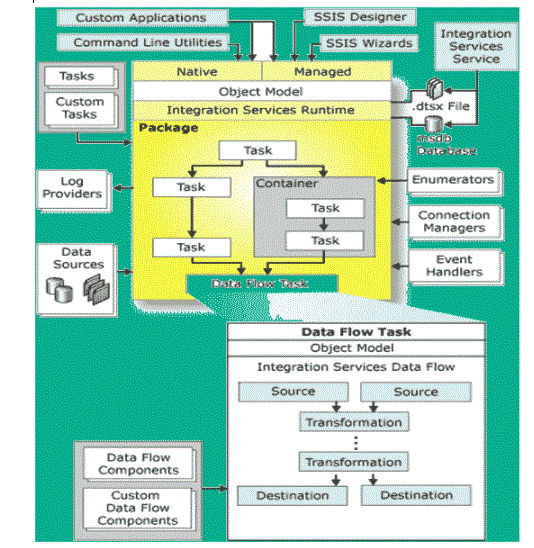
- Click OK and therefore the configuration is currently complete within the Execute SQL Task. In resolution human, Right-click on the SSIS package and click on Uninstall.
- The Red-Cross icon playing SQL Task indicates that package creation is unsuccessful.
- Click on the Progress tab for a close error message. By viewing the subsequent screenshot, we are able to see the error message.
- Configure SSIS package access
- Let’s harden SSIS entry into this package.
- Click Login, then open the SSIS Log Logs window.
- Mark the checkbox for the project and it permits work for this SSIS package.
- Provider and login to SSIS package
- In this tab, we have a tendency to choose the SSIS login supplier sort and their settings. We have the subsequent SSIS log suppliers out there here.
Different methods of SSIS Package Logging:
We could use the subsequent SSIS login strategies for troubleshooting functions.SSIS packages square measure log suppliers. Custom login messages victimisation scripts within the Execute SQL Task
In a project implementation model from SQL Server 2012, the SSIS catalogue provides performance logs on the SSISDB web site. In this article, we are going to examine the SSIS package log suppliers.
SSIS package log suppliers
For example, let’s produce an associated SSIS package to use SQL Script. In SQL Server knowledge Tools, produce a replacement integration services project. I additional a replacement SSIS package to associate existing project.
Drag the Execute SQL Task within the management Flow.
We need to organise the Execute SQL Task. Double-click on this operation to open the Execute SQL Task Editor.
Click the association sink and head to New association. It additionally shows the present connections to be used. Let’s use this link during this article. If you would like to make a replacement association, you’ll be able to offer the specified data like SQL Instance name, web site name, and confirmation within the association window.
In the SQL statement, specify the script you would like to use.
We want a similar sort of error message anytime a package will do a SQL Agent job. We want to piece together the SSIS Log.
Right-click on the flow management space, and it offers you a listing of choices.
In the message bar below, it provides the message ‘to set distinctive login choices, we want to alter your work in tree view’.
On the right, we are able to see 2 tabs for activation.
SSIS log supplier for text files: we have a tendency to use this log supplier to store data in TXT or CSV format. Typically, engineers use this format to store log data
SSIS Log SQL Server Log Provider: we are able to store SSIS logs in web site tables. It makes it simple to question logs victimisation t-SQL queries
SSIS Log Login for Windows Event Log: we are able to use this log supplier to send data to the app event viewer. The supply name for these events is SQLISPackage110. we have a tendency to don’t need any special configuration to work this supplier
SSIS Log supplier for SQL Server Profiler: DBA usually uses SQL Profiler to put in writing queries and investigate issues on SQL server. We have a tendency to use this log supplier to get SQL profile pursuit. we are able to specify associate .trc extension to open it with a SQL profile and examine package usage consistently.
SSIS log supplier for XML files: This log supplier stores package logs for XML files. We are able to piece XML files and open logs in tools like a browser, book or Visual Studio.
- The SSIS tool helps you to compile data from various data stores
- Switches management functions and data uploads
- Full of Data Marts & Data Warehouses
- Helps you clean and balance data
- Building a BI into a Data Transformation Process
- Automatic Data Management and Uploading Services
- SIS contains a GUI that helps users to convert data easily rather than writing large programs
- It can load millions of rows from one data source to another in just a few minutes
- Identifying, capturing, and processing data changes
- Coordinating data retention, processing, or analysis
- SSIS eliminates the need for strong programmers
- SSIS provides solid error and event management
Why we use SSIS:
Here are some important reasons for using the SSIS tool:
- Create a SQL Task As its name suggests, it will use the SQL statement against a related website.
- Data Flow Task This function can read data from one or more sources. Convert data when it is in memory and record it in one or more locations.
- Assignment Analysis Tools Use this function to process the objects of the Table model or as an SSAS cube. Use Package Work you can use this SSIS function to use other packages within the same project.
- Perform Process With the help of this function, you can specify command line parameters.
- File System Function Performs deception on file system. Such as moving, renaming, deleting files, and creating references.
- FTP Tasks Allows you to perform basic FTP tasks.
- Script Task This is an empty task. You can write a NET code that does any work; he wants to do.
- Send Email Activity You can send an email to let users know that your package has expired, or an error has occurred.
- Bulk Insert Task Use can load data into a table using the input command quantity. Script Activity Uses a set of VB.NET or C # encoding within the Visual Studio environment.
- Web Service Activity Uses a method for web service.
- WMI Event Viewer Function This function allows the SSIS package to wait and respond to specific WMI events.
- XML Function This function helps you to compile, separate, or re-format any XML file.
SSIS Tasks Types:
In the SSIS tool, you can add a function to control the flow. There are different types of jobs that do different types of jobs. Some of the key SSIS functions are listed below:
Job Name Definitions
- Extensive documentation and support
- Ease and speed of startup
- Strong integration with SQL Server and virtual studio
- Standard data integration
- Provides real-time, message-based capabilities
- Distribution model support
- It helps you to disassemble the network as the SSIS data entry bottle in SQL
- SISS lets you use SQL Server Destination instead of OLE DB to load data faster
- A few barriers to using SSIS tools are as follows:
- Sometimes create problems in non-windows
- Blurred vision and strategies
- SSIS does not support other data integration styles
- Problem integration with other products
Advantage and Disadvantage of SSIS:
The SSIS tool offers the following benefits:
SSIS inefficiency
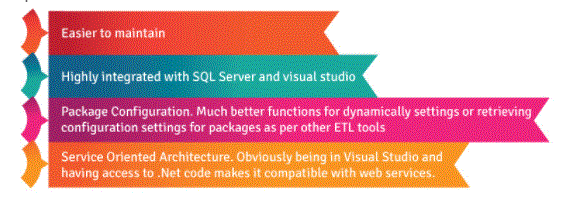
Conclusion:
The complete SSIS form is SQL Server Integration Services. The SSIS tool helps you to compile data from various data store. Important versions of SQL Serve Integration Service are 2005, 2008, 2012, 2014 and 216. Studio conditions, appropriate data integration functions, and active start-up speed are some of the key features of SSIS.
Flow Control, Data Flow, Event Holder, Package Checker, and Parameters are key components of SSIS architecture. Perform SQL Tasks, Data Flow Tasks, Analysis Services, Work Package, Process Tasks, File System Tasks, FTP Tasks, Shipping Tasks, Web Service and Other Essentials. Extensive documentation and support.
The biggest downside to SSIS is that it does not have the support of other data collection methods. SAP Data Services, SAS Data Management, Oracle Warehouse Builder (OWB), PowerCenter Informatica, IBM Infosphere Information Server. SSIS is a memory pipe. Therefore, it is important to ensure that all changes occur in memory.
